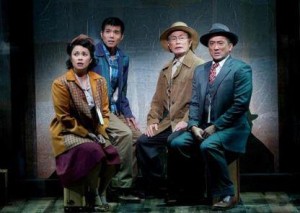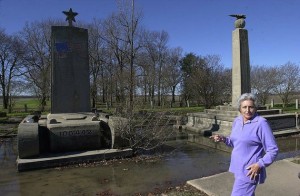George Takei Remarks at Grand Openings
The WWII Japanese American Internment Museum at McGehee and the interactive outdoor exhibits at the Rohwer Japanese American Relocation Center Cemetery both celebrated their Grand Opening on April 13, 2013. Actor George Takei, interned with his family at Rohwer, made remarks at both locations. The video above includes remarks at the museum, while the text below includes comments at the Rohwer site:
This is the third time that I’ve been back here since I left as a boy. The first time I came here with a lot of memories welling up in my mind, and trying to validate that. There were pools of water out here—barbed wire fence was right around here and there was a roadway and a ditch there, and I used to catch pollywogs in that ditch and watch them sprout legs and magically turn into frogs. And beyond the barbed wire fence there were pools of water and trees growing out of them. And so, in 2004, when I came back here, I wanted to remember whether those were real or not. When I got here, it was all gone. There was no swampy area at all. The land had been all drained, and the trees had been cut down and it was miles and miles of ripe cotton growing. It was cotton fields.
And the second time I came back was last year when I had the unique privilege of working with the Little Rock Symphony Orchestra, narrating a Schurenberg piece. And I wanted to spend that visit again to come back here to Rohwer. And I expected to see miles and miles of cotton fields, but they were all gone. It was just plain dirt, because it was wintertime—I think it was February. So, it was a totally different place from what I had expected to see.
And this third visit has been profoundly moving and heartwarming. All of you are here at this site, where I spent a small portion of my life. I’m 75 years old, and I was here when I was 5 and 6, so it’s just a very, very small portion of that 75 years—but it has been the most defining experience of my life. And it’s my incarceration here and in the other internment camp that has made me such an active participant in our democracy. And it is so gratifying to come back here and see all of you here who have worked to make this a hallowed ground for America—and certainly for me.
And the most important and moving piece of this land here is that cemetery. Because, in the middle of that cemetery is a crumbling monument which will very soon be restored. It’s a concrete monument that bears the names of a lot of Japanese-American men’s names. And it’s followed by the date and year that they passed, and the place where they died.
They were young men who went from imprisonment here, in this internment camp, to fight for this country: a country that was imprisoning us and taking all our rights away, including the word “citizen.” And now they wanted us to serve in the military. And they, indeed, did serve, with amazing, incredible heroism. They fought with unbelievable courage and, indeed, with incredible patriotism, and they sustained the highest combat casualty rate of any unit of its size. They fought in some of the most impossible battles.
The Gothic Line was one of the last strongholds of the Nazis. They were buried into this rock mountainside, and the Allied forces had been doing battle for a half a year—6 months. Many, many units had fought, and not removed the Nazi force.
The 442nd was called in to make that last push. It was an impregnable fortress, buried in that rocky mountainside. The 442nd had decided to do what was never done in any of the other assaults. The backside of that mountain was a sheer, rocky cliff—about a 400-foot drop. The Nazis didn’t expect an attack from that area. The men of the 442nd decided to do the impossible: to scale that sheer cliff, and attack from that side. And on a moonless night, in full combat gear, they began scaling that rocky cliff. And in the darkness, a few men lost their footing or their grip, and fell to their death in the ravine below. They all fell silently. Not a single man cried out. The others kept climbing. And at the first light of day, the men of the 442nd attacked.
They took the hill, and broke the Gothic Line. A six-month stalemate was broken by the men of the 442nd, in 32 minutes—an amazing achievement. A few of those men who perished in that battle are on that list here in the cemetery. They fought for their country with unbelievable heroism, and their patriotism was beyond American patriotism. They fought to prove they were Americans. They had to prove they’re Americans—and they didn’t just fight for mom’s apple pie, as almost all the others did. They fought to get ‘mom’ out of imprisonment. They are true, exemplary American heroes.
And I look forward to my fourth visit here, when I see that monument restored, as it should be. And that monument undisturbed, not only by the people of McGehee, or the people of Desha county, but all Americans. I hope that they travel from throughout this country here to Desha county to visit this cemetery and this monument, because it is a hallowed, American monument of American patriots.
So many people worked to make this happen—this actual site. I was told that the barrack that I lived in—block 6, barrack 2, unit M—was right around there, and they placed this platform here to signify that, and I feel very honored by that. We were near the barbed wire fence. I was here very briefly, just about a year, but my heart and my Americanism lies here. And I thank you all for what you’ve done to make this an important American landmark. Thank you from the bottom of my heart.





